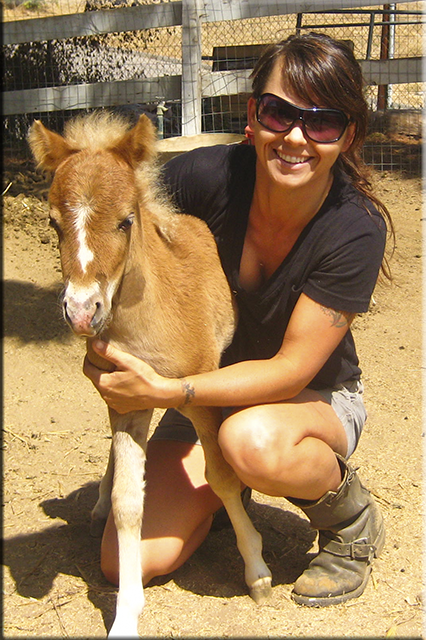
If you’re reading this, you probably have an interest in shipped chilled or frozen semen breeding. In the last few years, this area of the horse industry has dropped off considerably, probably approaching 50%. There is going to have to be a comeback at some point or there will be no horses to ride in the future, or the few that are around are going to be very valuable.
Shipped chilled breeding is a way to bring the stallion to you without having to ship your mare. From our end, it is a timing game. We have to determine that your mare is really in heat, then make a prediction about when she will ovulate. The shipment must be timed to arrive within a day or so prior to the day of ovulation. The closer the better, of course. Since only God can predict this event with complete accuracy, there will be some failures of timing in this method. It would help if you talk to the stallion owner about the success of the stallion in previous shipping seasons. The longer the sperm survives, the better chance we have of success if your mare decides to take her sweet time in building a follicle. As you can imagine, it will be easier to time the shipment if we have followed the mare through a cycle or two prior to breeding her so we have an idea about how she goes about things. This may not always be possible in the real world.
Of course, in any method of breeding, we need to determine that your mare is fertile prior to breeding. This often implies a culture of her uterus to determine that there is no infection. This is often done in a cycle prior to breeding her and it gives us a chance to follow her one time through a cycle.
Frozen semen breeding carries this whole program to a new degree of difficulty. (Didn’t they survive as a species for millions of years before we started complicating everything?) The good part about this method is that we have the semen in advance and have it on hand when we need it. We don’t have to worry about shipping on holidays and other problems. The bad part is that it doesn’t live very long and we need to get very close to ovulation. We try be within eight hours of ovulation, and can assure you that this is easier said than done. Our approach to this problem is to ultrasound the mare frequently (2-3 times per day) as she approaches ovulation. Here again, the fertility of the stallion is very important. Some stallions freeze well, some not so well. You should get any information you can from the breeder about success of the horse in previous seasons.
As you may have guessed, we prefer to have your mare at our little place for this. It makes it much easier for us and cheaper for you to have your mare on hand when she needs to be examined rather than having to drive over to your place a bunch of times. We house our mares in 24 x 24 pens in a mare motel configuration.
We have worked extensively in equine reproduction. We currently provide service to several large breeding farms. Dr. Talbot has performed over 15,000 ultrasound exams of the mare reproductive tract.
Shipped chilled breeding is a way to bring the stallion to you without having to ship your mare. From our end, it is a timing game. We have to determine that your mare is really in heat, then make a prediction about when she will ovulate. The shipment must be timed to arrive within a day or so prior to the day of ovulation. The closer the better, of course. Since only God can predict this event with complete accuracy, there will be some failures of timing in this method. It would help if you talk to the stallion owner about the success of the stallion in previous shipping seasons. The longer the sperm survives, the better chance we have of success if your mare decides to take her sweet time in building a follicle. As you can imagine, it will be easier to time the shipment if we have followed the mare through a cycle or two prior to breeding her so we have an idea about how she goes about things. This may not always be possible in the real world.
Of course, in any method of breeding, we need to determine that your mare is fertile prior to breeding. This often implies a culture of her uterus to determine that there is no infection. This is often done in a cycle prior to breeding her and it gives us a chance to follow her one time through a cycle.
Frozen semen breeding carries this whole program to a new degree of difficulty. (Didn’t they survive as a species for millions of years before we started complicating everything?) The good part about this method is that we have the semen in advance and have it on hand when we need it. We don’t have to worry about shipping on holidays and other problems. The bad part is that it doesn’t live very long and we need to get very close to ovulation. We try be within eight hours of ovulation, and can assure you that this is easier said than done. Our approach to this problem is to ultrasound the mare frequently (2-3 times per day) as she approaches ovulation. Here again, the fertility of the stallion is very important. Some stallions freeze well, some not so well. You should get any information you can from the breeder about success of the horse in previous seasons.
As you may have guessed, we prefer to have your mare at our little place for this. It makes it much easier for us and cheaper for you to have your mare on hand when she needs to be examined rather than having to drive over to your place a bunch of times. We house our mares in 24 x 24 pens in a mare motel configuration.
We have worked extensively in equine reproduction. We currently provide service to several large breeding farms. Dr. Talbot has performed over 15,000 ultrasound exams of the mare reproductive tract.
Images by Dr. Talbot and Erdenebayar on Pixabay


